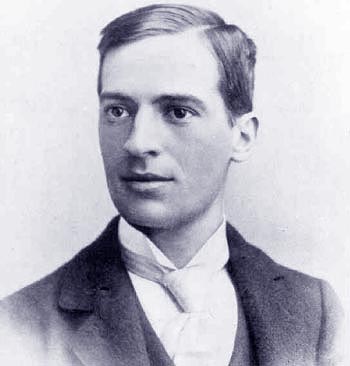Harry Nelson Pillsbury, Somerville, MA USA; died Philadelphia, PA USA.
He learned to play chess at the age of sixteen, when he was encouraged by family to study chess as a distraction after his mother died. Within four years Pillsbury had improved to the point of winning a three-game match from Wilhelm Steinitz in 1892 by the score of 2-1 at the odds of pawn and move. He also scored one of two wins against Steinitz in the World Champion's 20-board simultaneous exhibition. In 1893, he won a close match against John F Barry (+5 -4 =1) that earned him entry into his first international tournament in New York as Boston's representative. Although the congress fell through, most likely due to problems in the financial world, the so-called "Impromptu" 1893 tournament was organized in its place. Playing in his first tournament with European masters, Pillsbury barely managed a plus score and finished seventh. Pillsbury returned to New York a few months later and finished clear first in the 1893 New York Masters (sometimes called the "Manhattan Cafe") tournament ahead of a number of American masters. Pillsbury then moved to New York and began working at the Eden Musee as the operator of a chess and checkers playing automaton. In 1894, Pillsbury finished second to Jackson Showalter in a small tournament in Buffalo (Staats-Zeitung Cup) and had a poor result of =5th in a master's tournament in New York. Nevertheless, he still made a sufficiently good impression for the Brooklyn Chess Club to sponsor his trip to the 1895 chess congress in Hastings.
At Hastings, Pillsbury stunned the chess world by taking clear first in perhaps the greatest tournament of the 19th Century, ahead of a field that included Mikhail Chigorin, Emanuel Lasker, Siegbert Tarrasch, Wilhelm Steinitz, Joseph Blackburne, Amos Burn, Richard Teichmann and others. On the basis of this result, Pillsbury was invited to an elite four-player tournament in St. Petersburg, with Lasker, Steinitz, and Chigorin. Pillsbury was leading by a full game halfway through the tournament (+5 -1 =3), but fell ill during the second half, with catastrophic results (+0 -6 =3). Had Pillsbury managed to win or finish a close second he might well have secured the world championship match that eluded him. Nevertheless, this was the start of a successful tournament career that included 1st at Buffalo 1901, =1st at Vienna 1898 and Munich 1900, 2nd at Paris 1900, Monte Carlo 1902, and Hanover 1902, =2nd at London 1899, 3rd at St. Petersburg 1895-6, Budapest 1896, and Monte Carlo 1903, =3rd at Nuremberg 1896, and 4th at the Vienna Gambit tournament 1903. Pillsbury only seriously faltered at the very end, finishing =8th with a minus score at Cambridge Springs 1904, in his last tournament.
Pillsbury negotiated the final terms of the first Anglo-American cable match with Sir George Newnes, president of the London Chess Club. Sir George donated the Newnes Cup, held by the winning team each year until the next match. Pillsbury played on the first board for the US team in the first eight cable matches (+1 -2 =5). Pillsbury also helped prepare the US House of Representatives team for their 1897 cable match against the House of Commons.
Pillsbury was considered the strongest player in the US. He played two matches for the US championship against Showalter, winning both of the Pillsbury - Showalter US Championship (1897) (+10-8=3) and Pillsbury - Showalter US Championship (1898) (+7-3=2) matches. However Pillsbury was not especially eager to be named US champion: "I was not seeking the match, and even if I should win I shall leave Showalter in possession of the title; I am not in search of any title but one." The "one" title was, of course, World Champion. Pillsbury wrote to New York following his success at Hastings that there had been some talk of arranging a title match with Lasker, but, as with so many proposed world championship matches over the years, nothing came of it.
Pillsbury was accomplished at blindfold chess and often playing mutiple games blindfolded in his exhibitions. He set an early world record for number of simultaneous blindfold games, playing 20 games at Philadelphia in 1900. He was also a skilled checkers player, and would sometimes include checkers and whist games in his exhibitions. Pillsbury's exhibitions were quite impressive for the day. Jose Raul Capablanca wrote: "The effect of Pillsbury's displays was immediate. They electrified me, and with the consent of my parents I began to visit the Havana Chess Club."
Pillsbury played a number of consultation games over the years. Such games were sometimes played on off days of tournaments between players with no adjourned games. Pillsbury played with or against masters such as Henry Bird, Blackburne, Chigorin, David Janowski, Lasker, William Napier, Georg Marco, Frank Marshall, Carl Schlechter, Showalter, Tarrasch, Teichmann, and others.
While there is general agreement that Pillsbury died of syphilis, it is unknown when he contracted the disease. Syphilis shows great variability in its time course across patients and can easily mimic symptoms of other diseases, so a definitive answer is unlikely. Pillsbury was ill during the second half of the St. Petersburg tournament, which was attributed to influenza at the time. He was also quite ill during the Nuremberg tournament, and, of course, during Cambridge Springs. He suffered two strokes during the last year and a half of his life.
Pillsbury wrote no chess books. He wrote occasional newspaper reports on tournaments and matches and wrote a column for the Philadelphia Inquirer. Although there are few known correspondence games played by Pillsbury, one of the early correspondence chess organizations in the US was named in his honor (Pillsbury National Correspondence Chess Association).
Wikipedia article: Harry Nelson Pillsbury







